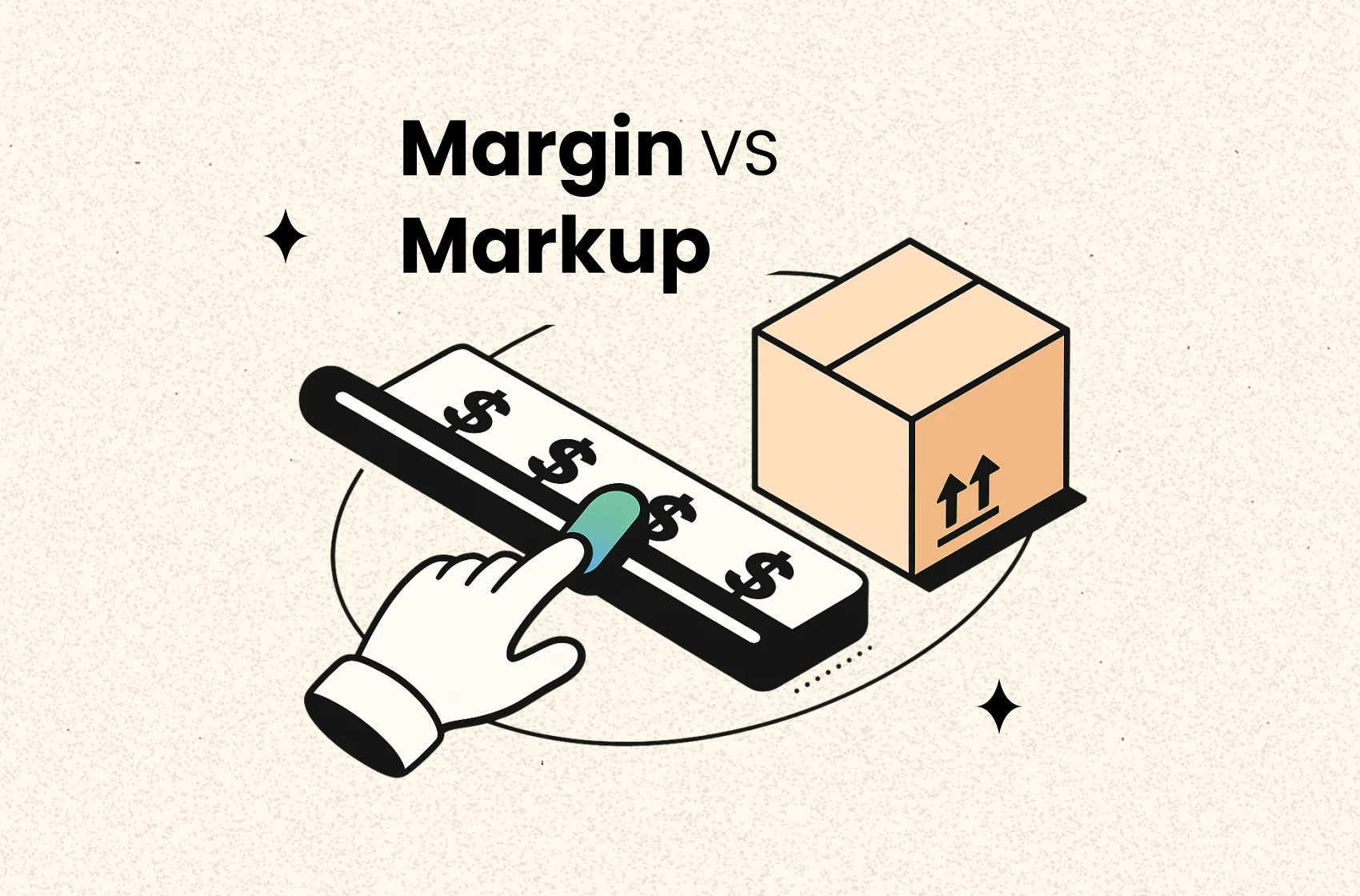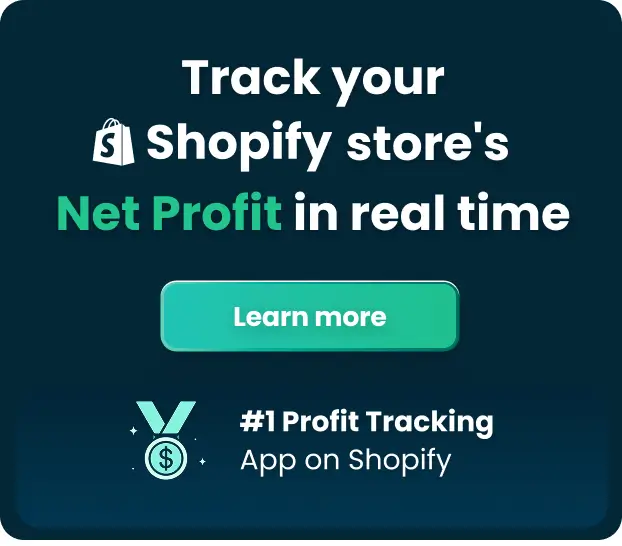Margin vs. Markup Explained: Formulas & Key Differences

If you’ve ever confused markup with margin, you’re not alone and if you run an eCommerce store, knowing the difference directly impacts your profit. Here’s the quick answer on what is margin vs markup:
- Markup is how much you increase your product cost to set a selling price.
- Margin is the percentage of revenue that turns into profit after covering the cost of goods.
In short: Markup starts from cost. Margin starts from price. Understanding both helps you price smarter, assess profitability more accurately, and avoid common pricing mistakes - especially when discounts, fees, and ad costs get involved. This article will walk you through the margin vs markup formula, how to calculate margin vs markup, and real-world examples tailored to Shopify and eCommerce.
Margin vs. Markup: What’s the Difference?
If you run an ecommerce business, understanding margin vs. markup is critical to setting profitable prices. While these two ecommerce metrics sound similar, these two measure profit in very different ways and mixing them up can hurt your bottom line. Let’s break it down by margin vs markup definition.
What Is Margin?
Margin (or profit margin) is the percentage of your selling price that is profit after covering the cost of goods sold (COGS). Understanding your margin is key to managing your overall profitability and cash flow.
For a deeper dive into tracking your store’s financial health, check out our comprehensive guide on profit and loss (P&L) statement.
Margin Formula:
Margin Example:
Let’s say you sell a product for $50, and it costs you $30.
That means 40% of your revenue is profit. This is a key metric for evaluating how much of your sales revenue is left after costs. To quickly calculate your margin, try this free profit margin calculator.
What Is Markup?
Markup shows how much you’ve increased your cost price to set your selling price. It’s calculated as a percentage based on cost, not revenue.
Markup Formula:
Markup Example:
Same product: selling price is $50, cost is $30.
In other words, you’ve marked up your product by 66.67% from its original cost.
Markup vs. Margin Explained
Even though they both describe profit, they use different reference points - leading to very different percentages. Here’s the key difference between margin and markup:
Metric | Based On | Formula | Example Result |
|---|---|---|---|
Margin | Selling Price | (Selling Price – Cost) ÷ Selling Price × 100 | 40% |
Markup | Cost | (Selling Price – Cost) ÷ Cost × 100 | 66.67% |
When to Use Margin vs. Markup in Your Ecommerce Business
Knowing when to use margin and when to use markup is just as important as understanding the difference. Each metric serves a specific purpose in pricing, profitability analysis, and business decisions.
When to Use Margin
Use margin when you want to understand how much profit you keep from each sale relative to the selling price. This is essential for:
- Evaluating overall profitability: Margin tells you what percentage of your revenue is profit after covering costs.
- Setting profit goals: Retailers and brands often set target margins to ensure sustainable growth.
- Assessing discount impacts: When running promotions or sales, tracking margin helps you see how reduced prices affect your profits.
- Financial reporting: Margin is commonly used in income statements and key performance indicators (KPIs).
When to Use Markup
Use markup when you’re focused on how much you increase your cost price to reach a selling price. It’s particularly useful for:
- Pricing products: Markup helps you set prices that cover your costs plus desired profit.
- Calculating wholesale prices: Wholesalers often use markup percentages based on cost to set their prices.
- Budgeting costs: Markup clarifies the profit margin you’re building on top of your costs.
- Comparing supplier offers: Understanding markup helps evaluate how supplier costs affect your pricing power.
Why Using Both Markup and Margin Matters?
Although most would say use margin to measure profit relative to sales revenue and for financial health checks and use markup when pricing products and calculating how much to add to your costs.
A smart ecommerce business owner will be calculating margin vs markup. First, determine the markup needed to hit your target margin and sales goals. Then track margin regularly to ensure your prices and promotions maintain profitability.
But manually calculating and tracking these figures can get complicated as your store grows. That’s where TrueProfit comes in.


TrueProfit's Dashboard
TrueProfit is a profit analytics solution that automates tracking by calculating real-time margins and markups at both product and order levels. Beyond just automated calculations, it provides actionable insights into your actual profitability - helping you make smarter pricing decisions and avoid costly mistakes with confidence.
Markup vs. Margin FAQs
What is the difference between 30% margin and 30% markup?
A 30% margin means the profit is 30% of the selling price. A 30% markup means the profit is 30% of the cost price. Margin is profit ÷ selling price; markup is profit ÷ cost price.
Should I use markup or margin?
Use margin to understand your profit as a percentage of the selling price, which helps with pricing decisions. Use markup when you want to know how much to add to cost to set the selling price.
What is 20% markup as margin?
A 20% markup equals about a 16.7% margin. Margin is always less than markup when expressed as a percentage.
Is 100% markup the same as 50% margin?
Yes. A 100% markup means the selling price is double the cost, which equals a 50% margin.
Is 30% profit margin too high?
A 30% margin is healthy for many industries but depends on your business model and costs. Some stores operate on lower margins but higher volume.
What is a 30% margin on $100?
A 30% margin on $100 means the profit is $30, so the cost is $70.
Is 20% margin too much?
A 20% margin can be good or low depending on your industry and business goals. Many ecommerce stores aim for margins between 20-50%.
How is markup calculated?
Markup = (Selling Price - Cost) ÷ Cost × 100%
How to add 20% margin to a cost?
To price with a 20% margin: Selling Price = Cost ÷ (1 - 0.20)
What does 30 percent margin mean?
It means 30% of the selling price is profit after covering the cost of goods sold.
How to convert margin to markup?
Markup = Margin ÷ (1 - Margin) × 100%
How much is 30 percent markup?
30% markup means adding 30% of the cost to the cost to set the selling price.
What is the difference between margin and markup in construction?
In construction, margin is profit percentage based on the final price charged; markup is the percentage added to cost to cover expenses and profit.
Tracy is a senior content executive at TrueProfit – specializing in helping eCommerce businesses scale profitably through content. She has over 4 years of experience in eCommerce and digital marketing editorial writing. She develops high-impact content that helps thousands of Shopify merchants make data-driven, profit-focused decisions.













![What Is a Good Gross Profit Margin? [2025 Benchmarks]](https://be.trueprofit.io/uploads/Gross-profit-margin.webp)
 Shopify profits
Shopify profits